Dover
Index
Dover Castle Churches |
St Mary-in-Castro
|
| |
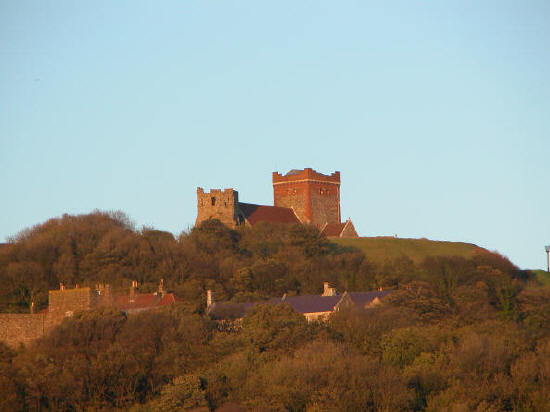
|
| |
The church of St Mary-in-Castro, or St
Mary-in-the-Castle, stands on a raised earthwork thought to date from
pre-Roman times. This picture, taken from the Sea Front, shows
it illuminated by a winter sunset. A section of the Castle walls
with one of the towers can be seen on the left of the picture, while
on the far right you can see one of the chain of beacons that were
built in 1988 to celebrate the 400th anniversary of the defeat of the
Armada.
"It is said to be the oldest church in the country, and it
certainly was the first built in Dover. When it was founded,
about the year 180 the whole of the population of Dover occupied
this hill top. During a long lapse into heathenism this Church
fell into ruin, but it was reconstructed under Augustine, the first
Bishop of Canterbury, about A.D. 600, and King Eadbald, A.D. 620
established a college of Secular Canons, who served this church
until they were removed to their new house and church of St. Martin
beside the River Dour A.D. 700. After that date the services
of the Castle Church were continued by three Chaplains, supported
out of the Manor of Cocklescombe in the Parish of Lydden; but, after
the Reformation their number was reduced to one. There was a
regular succession of chaplains until A.D. 1690, when, owing to the
ruinous state of the church, public worship therein was
discontinued. After that the stipend, amounting to between
thirty and forty pounds continued to be paid for more than a
century, but the recipient never did duty. This church was
used by the Castle Garrison for about 600 years, and during that
time many distinguished persons were buried within it, while for the
soldiers and their families there was a burial ground on the south
and east sides of the church, within the limits of the Roman
entrenchment. After the discontinuance of the services in 1690
the burials in the Castle Churchyard ceased, the Castle Garrison
interments, which were few, taking place mostly at St. James's
Church." (JBJ 1916)
|
|
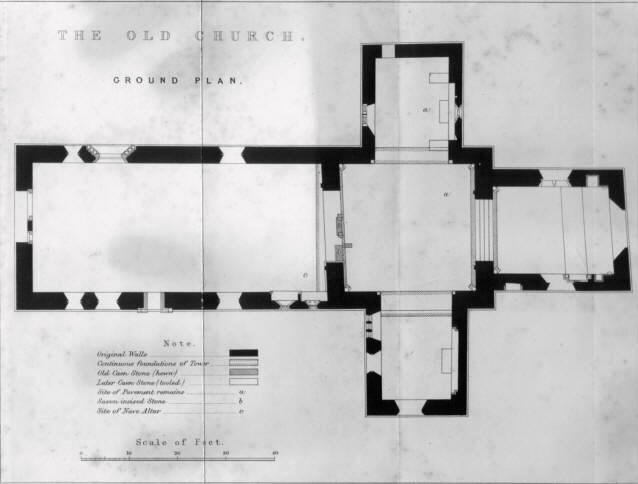
Plan of church from Puckle (1864) |
| |
The church fell into ruins in the Stuart period and was restored by Sir
Gilbert Scott in 1860. Apparently, the bells of the church were
originally hung in the Pharos tower, which was extended for the purpose;
when they ceased to be used, they were given to a church in Portsmouth.
This gave rise to the saying that the bells of Dover Castle could be heard
in Portsmouth. |
|
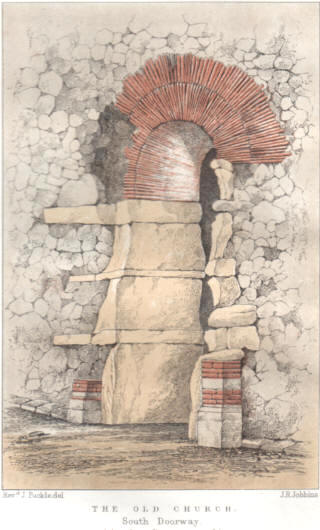
South Doorway from Puckle (1864) |
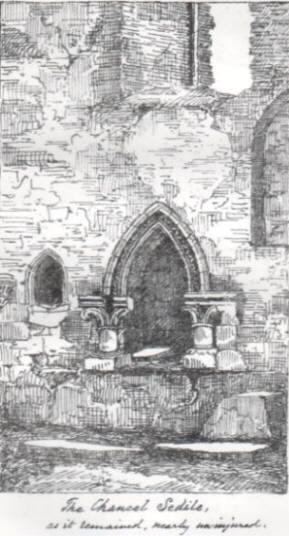
Chancel Sedile from Puckle (1864) |
The church plate was lent to the clergy of St. James's,
which was then used by the garrison.
|
| |
"In 1780 the ruins of the Castle Church were converted into a
cooperage and storehouse, and in 1794 it was transformed into a
barrack room, but, on Christmas Day, 1801, the south-west corner of
the nave collapsed, and large portions of the south and west walls
fell. The interior was then choked up with debris, but in 1808
it was cleared out and used as a coal store. Having been
reduced to these base uses for a period of 170 years, in 1860 its
restoration was taken hand by Sir Gilbert Scott, on behalf of the
War Department, and in 1862, the edifice with its ancient
architectural features carefully preserved, was re-opened as the
Castle Garrison Church, and placed in charge of the Senior Chaplain
of the Forces at Dover." (JBJ 1916)
|
|
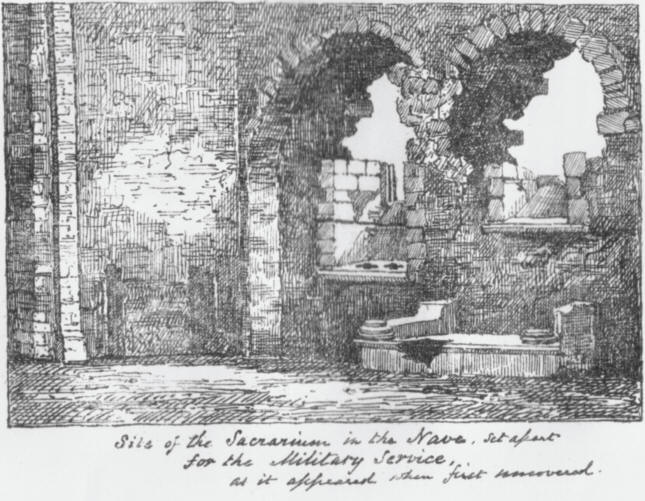
Sacrarium from Puckle (1864) |
| |
"The Rev. Canon Puckle, who very minutely examined the
structure during its restoration in 1860, and Mr. Loftus Brock, Secretary
of the Royal Archaeological Institute, both regarded this church as of
Roman period; and the Rev. S. P. H. Statham, who appears to have very
carefully considered all that has been written about it, came to the
conclusion that the church was originally built as a Roman fortress,
probably in the first century of the Christian era, and converted into a
church during the last century of the Roman occupation of Britain."
(J.B.J. 1907)
|
| |
It would seem that Bavington Jones did not read what
Canon Puckle had to say in his description of the building:
"... the plainest argument is furnished by the consideration
of the materials themselves. Without dwelling on the absence
of any recorded testimony, wee see, I think, internal evidence
enough against any pure Roman origin of this building. There
is no tufa to be found in it, while tufa may be called almost the
staple material of the Roman tower adjoining. So very
characteristic a sign of Roman building must indicate by its absence
that Roman builders were not the workmen here. And the
interval must probably have been considerable between the time when
this material was so freely employed, and when it had passed so
entirely into disuse.
"Again, neither of the two descriptions of concrete, or
mortar, found in the Tower, can be identified with that which occurs
uniformly in all parts of the Church. The difference might not
be thought great; but it is peculiar and well-defined. The
former was a more simple concrete, consisting mostly of red brick
coarsely ground up, and lime; in the latter the use of pounded brick
no longer remained, but ingredients and proportions more like those
now in common use, of small gravel, lime, and sand. And though
there is nothing in this to indicate the limits of any interval, it
clearly assists in pointing to some considerable difference between
the respective periods of the Pharos and the Church."
(Rev. J. P. 1864)
After considering the quality of the architecture, which he
suggests is influenced by the Romans and of a much higher standard in
both design and construction than that of the Anglo-Saxon period,
Puckle concludes that the likely date for the founding of the church
is the early part of the 4th century.
|
| |
The Parish Records for St. Mary-in-Castro can be found
with those of Guston, in which parish the church was originally
situated. They are deposited at the Canterbury Cathedral
Archives. |




